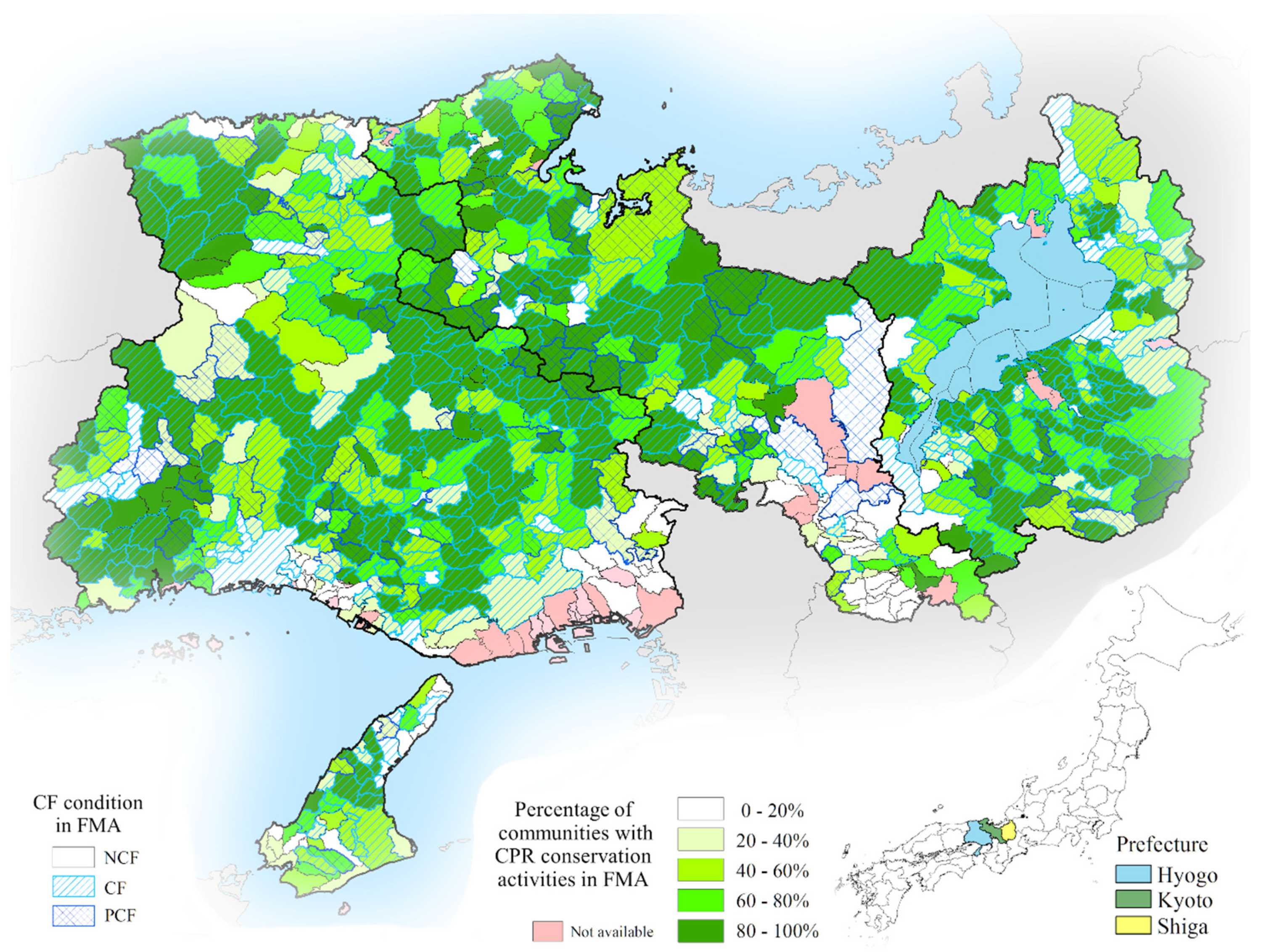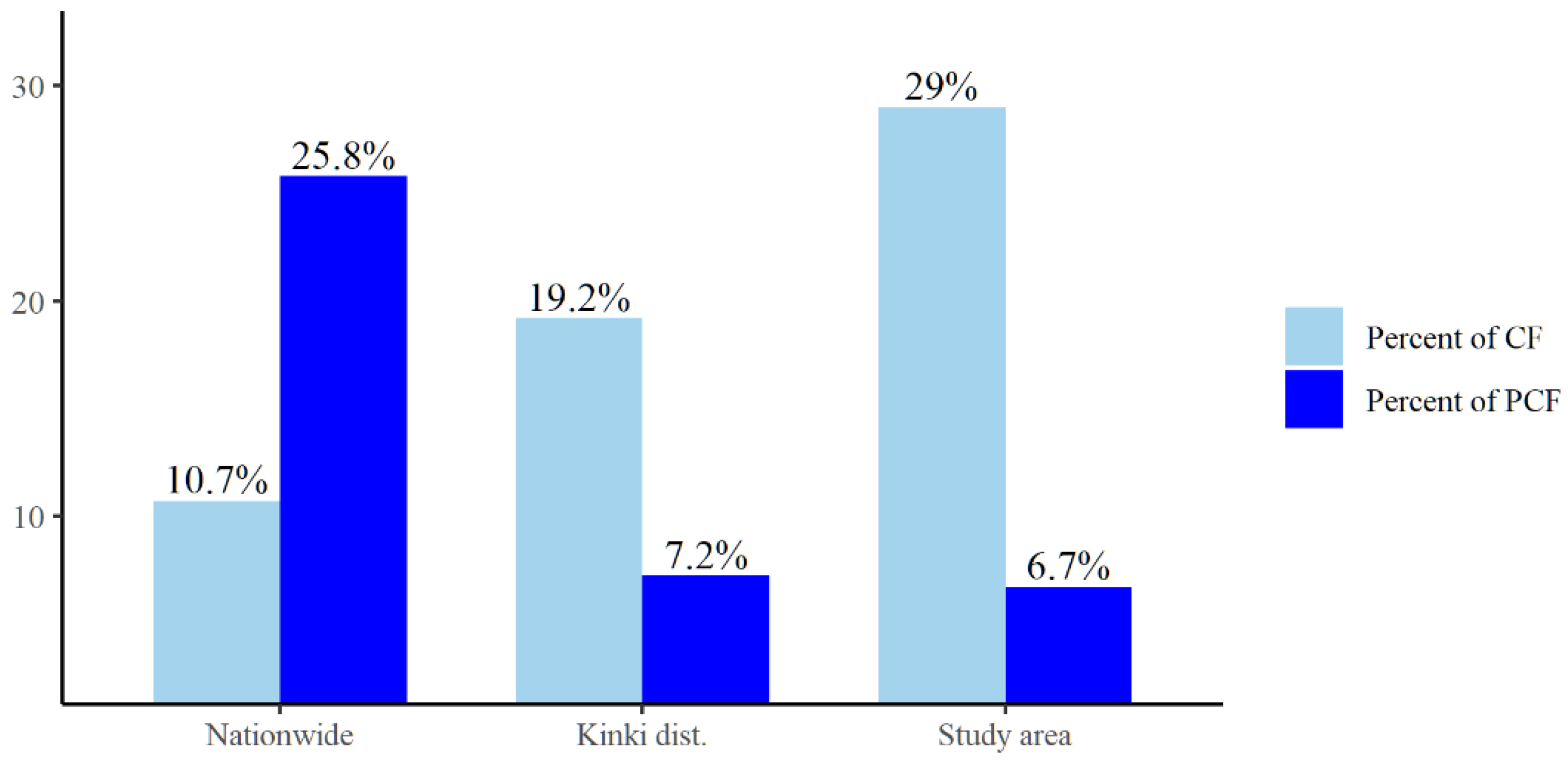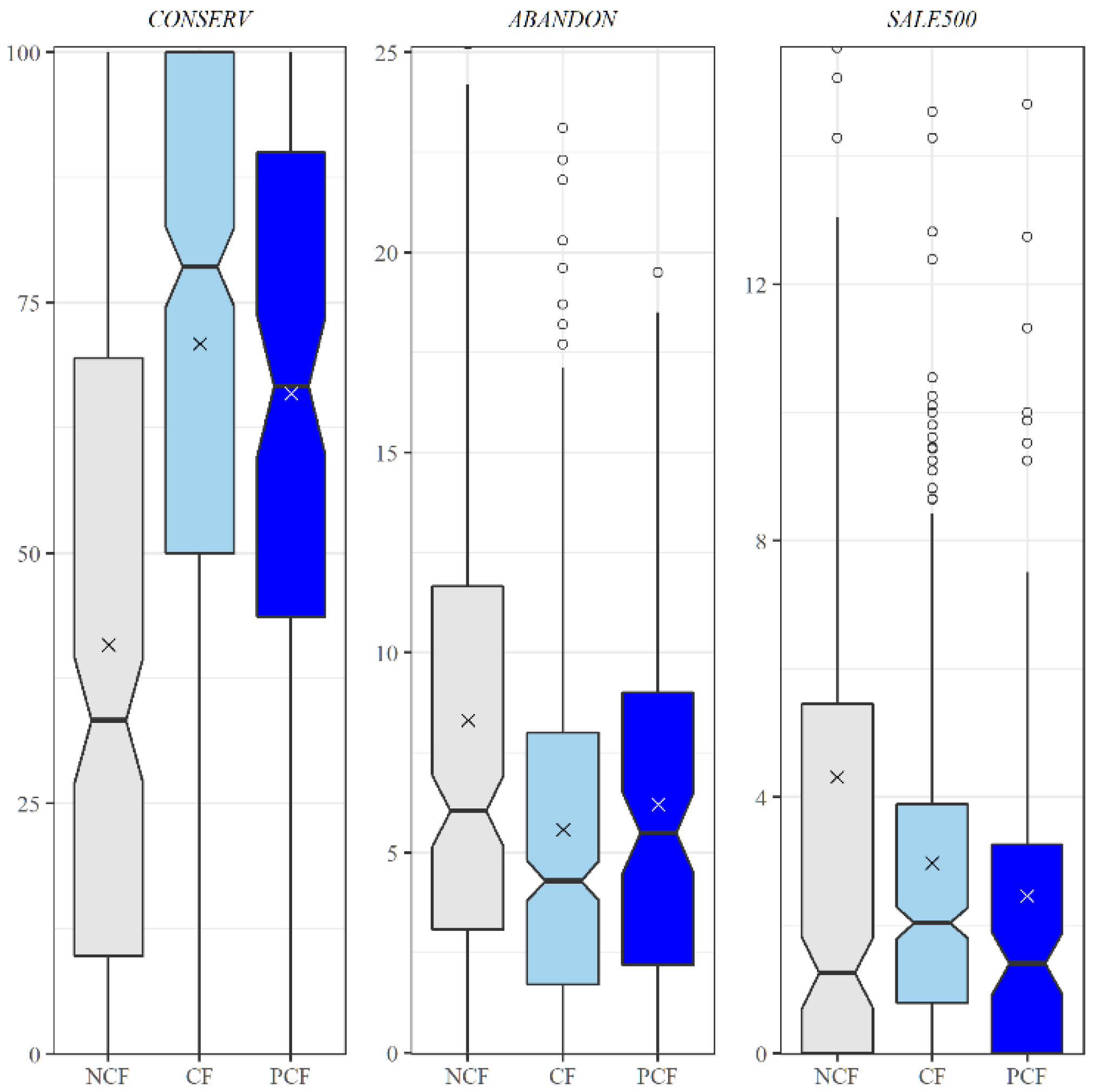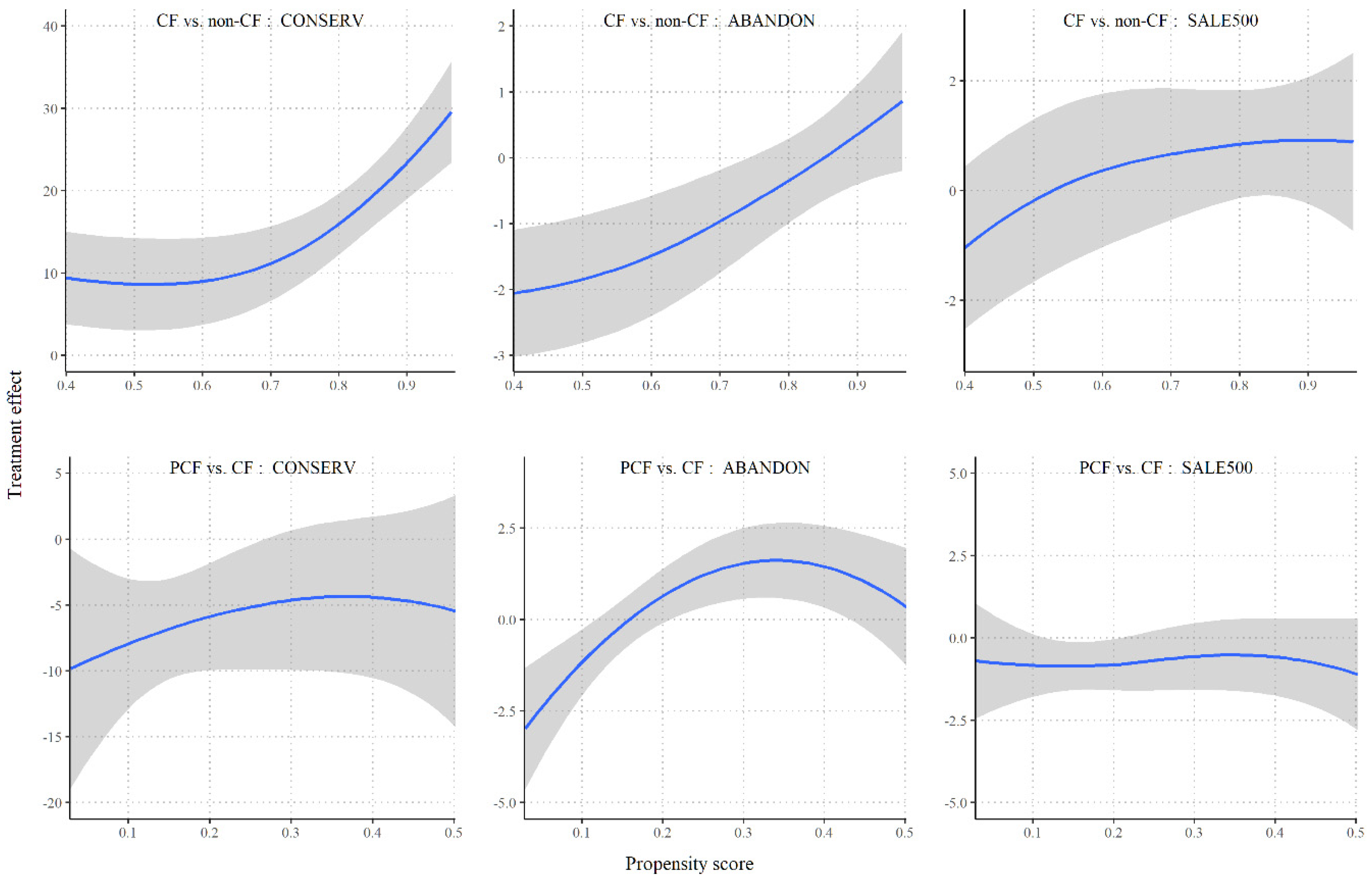Formation Factors and Effects on Common Property Resource Conservation of Community Farms
Abstract
1. Introduction
2. Methodologies and Data
2.1. Coding Method for Community Farms
2.2. Study Area
2.3. Propensity Score Matching (PSM)
2.4. Data
2.4.1. Outcomes of Causal Inference
2.4.2. Covariates for Probit Estimation
3. Estimation results
3.1. Propensity Scores (PSs) by Probit Estimations
3.2. Average Treatment Effect (ATE)
3.3. Robustness Check and Heterogeneous Treatment Effect
4. Discussion
5. Conclusions
Funding
Conflicts of Interest
Appendix A
| ANOVA | Multiple Comparison Test | |||||||
|---|---|---|---|---|---|---|---|---|
| C-N | P-N | P-C | ||||||
| NCOM | 0.000 | *** | 0.000 | *** | 0.000 | *** | 0.003 | *** |
| FHH | 0.000 | *** | 0.000 | *** | 0.159 | 0.016 | ** | |
| PFARM | 0.000 | *** | 0.000 | *** | 0.000 | *** | 0.127 | |
| NFARM | 0.000 | *** | 0.006 | *** | 0.006 | *** | 0.425 | |
| AAREA | 0.000 | *** | 0.000 | *** | 0.389 | 0.054 | * | |
| RENTOUT | 0.000 | *** | 0.000 | *** | 0.005 | *** | 0.748 | |
| OV5 | 0.009 | *** | 0.043 | ** | 0.936 | 0.098 | * | |
| SUCCESS | 0.000 | *** | 0.000 | *** | 0.000 | *** | 0.397 | |
| AGEU40 | 0.009 | *** | 0.231 | 0.068 | * | 0.004 | *** | |
| RICE | 0.000 | *** | 0.000 | *** | 0.000 | *** | 0.036 | ** |
| MEET | 0.000 | *** | 0.000 | *** | 0.000 | *** | 0.036 | ** |
| MPS | 0.048 | ** | 0.119 | 0.043 | ** | 0.232 | ||
| DPHM | 0.000 | *** | 0.000 | *** | 0.001 | *** | 0.001 | *** |
| DEPOP | 0.493 | 0.982 | 0.676 | 0.676 | ||||
| SLOPE | 0.004 | *** | 0.015 | ** | 0.015 | ** | 0.405 | |
| HMA | 0.009 | *** | 0.110 | 0.008 | *** | 0.110 | ||
| HYOGO | 0.474 | 0.861 | 0.680 | 0.680 | ||||
| KYOTO | 0.000 | *** | 0.000 | *** | 0.292 | 0.000 | *** | |
| SHIGA | 0.000 | *** | 0.000 | *** | 0.899 | 0.000 | *** | |
| NCF vs. CF | CF vs. PCF | |||||||
|---|---|---|---|---|---|---|---|---|
| SMD | VR | SMD | VR | |||||
| Raw | Matched | Raw | Matched | Raw | Matched | Raw | Matched | |
| NCOM | 0.490 | 0.031 | 0.355 | 1.393 | 0.490 | 0.031 | 0.355 | 1.393 |
| FHH | 0.373 | 0.109 | 1.321 | 1.121 | 0.373 | 0.109 | 1.321 | 1.121 |
| FHH2 | 0.168 | 0.085 | 1.057 | 0.677 | 0.168 | 0.085 | 1.057 | 0.677 |
| PFARM | 0.314 | 0.093 | 2.537 | 1.162 | 0.314 | 0.093 | 2.537 | 1.162 |
| NFARM | 0.288 | 0.043 | 0.584 | 0.683 | 0.288 | 0.043 | 0.584 | 0.683 |
| AAREA | 0.278 | 0.057 | 1.366 | 0.776 | 0.278 | 0.057 | 1.366 | 0.776 |
| RENTOUT | 0.381 | 0.010 | 0.855 | 1.059 | 0.381 | 0.010 | 0.855 | 1.059 |
| OV5 | 0.144 | 0.073 | 2.355 | 0.928 | 0.144 | 0.073 | 2.355 | 0.928 |
| SUCCESS | 0.539 | 0.084 | 2.788 | 0.837 | 0.539 | 0.084 | 2.788 | 0.837 |
| AGEU40 | 0.025 | 0.004 | 1.327 | 0.867 | 0.025 | 0.004 | 1.327 | 0.867 |
| RICE | 0.647 | 0.065 | 3.833 | 1.467 | 0.647 | 0.065 | 3.833 | 1.467 |
| MEET | 0.682 | 0.087 | 1.046 | 1.036 | 0.682 | 0.087 | 1.046 | 1.036 |
| MEET2 | 0.406 | 0.047 | 0.467 | 0.812 | 0.406 | 0.047 | 0.467 | 0.812 |
| MPS | 0.180 | 0.117 | 0.973 | 0.819 | 0.180 | 0.117 | 0.973 | 0.819 |
| DPHM | 0.682 | 0.175 | 1.184 | 2.403 | 0.682 | 0.175 | 1.184 | 2.403 |
| DEPOP | 0.026 | 0.156 | 0.949 | 0.783 | 0.026 | 0.156 | 0.949 | 0.783 |
| SLOPE | 0.254 | 0.073 | 0.888 | 0.993 | 0.254 | 0.073 | 0.888 | 0.993 |
| HMA | 0.183 | 0.099 | 1.043 | 0.933 | 0.183 | 0.099 | 1.043 | 0.933 |
| KYOTO | 0.325 | 0.249 | 1.351 | 1.143 | 0.325 | 0.249 | 1.351 | 1.143 |
| SHIGA | 0.387 | 0.059 | 0.553 | 0.901 | 0.387 | 0.059 | 0.553 | 0.901 |
References
- Wade, R. The Management of Common Property Resources: Finding a Cooperative Solution. World Bank Res. Obs. 1987, 2, 219–234. [Google Scholar] [CrossRef]
- FAO. Governing Tenure Rights to Commons. Available online: http://www.fao.org/family-farming/detail/en/c/1027659/ (accessed on 25 March 2020).
- Ito, J.; Feuer, H.N.; Kitano, S.; Komiyama, M. A Policy Evaluation of the Direct Payment Scheme for Collective Stewardship of Common Property Resources in Japan. Ecol. Econ. 2018, 152, 141–151. [Google Scholar] [CrossRef]
- Ostrom, E.; Gardner, R. Coping with Asymmetries in the Commons: Self-Governing Irrigation Systems Can Work. J. Econ. Perspect. 1993, 7, 93–112. [Google Scholar] [CrossRef]
- Shogenji, S. Japan’s Position in the Context of Agricultural Trade Issues. Jpn. J. Agric. Econ. 2019, 21, 56–62. [Google Scholar] [CrossRef]
- Tada, R.; Ito, J. The Economic Performance of Paddy Field Farming in Japan and the Causal Effect of Direct Payments. J. Rural Econ. 2018, 89, 261–276. [Google Scholar] [CrossRef]
- Ito, J.; Feuer, H.N.; Kitano, S.; Asahi, H. Assessing the effectiveness of Japan’s community-based direct payment scheme for hilly and mountainous areas. Ecol. Econ. 2019, 160, 62–75. [Google Scholar] [CrossRef]
- MAFF. Summary of the Basic Plan for Food, Agriculture and Rural Areas—Food, Agriculture and Rural Areas Over the Next 10 Years. Available online: https://www.maff.go.jp/e/policies/law_plan/index.html (accessed on 15 March 2020).
- Chen, S.; Lan, X. There Will Be Killing: Collectivization and Death of Draft Animals. Appl. Econ. 2017, 9, 58–77. [Google Scholar] [CrossRef]
- Brooks, K.; Lerman, Z. Land Reform and Farm Restructuring in Russia: 1992 Status. Am. J. Agric. Econ. 1993, 75, 1254–1259. [Google Scholar] [CrossRef]
- Ravenscroft, N.; Moore, N.; Welch, E.; Hanney, R. Beyond Agriculture: The Counter-Hegemony of Community Farming. Agric. Hum. Values 2013, 30, 629–639. [Google Scholar] [CrossRef]
- Liu, P.; Gilchrist, P.; Taylor, B.; Ravenscroft, N. The Spaces and Times of Community Farming. Agric. Hum. Values 2017, 34, 363–375. [Google Scholar] [CrossRef]
- Matsuno, Y.; Nakamura, K.; Masumoto, T.; Matsui, H.; Kato, T.; Sato, Y. Prospects for Multifunctionality of Paddy Rice Cultivation in Japan and Other Countries in Monsoon Asia. Paddy Water Environ. 2006, 4, 189–197. [Google Scholar] [CrossRef]
- Sato, H. Toward Preservation of the Multi-Functional Roles of Paddy Field Irrigation. Paddy Water Environ. 2005, 3, 1–3. [Google Scholar] [CrossRef]
- Fujiie, M.; Hayami, Y.; Kikuchi, M. The Conditions of Collective Action for Local Commons Management: The Case of Irrigation in the Philippines. Agric. Econ. 2005, 33, 179–189. [Google Scholar] [CrossRef]
- Narloch, U.; Pascual, U.; Drucker, A.G. Collective Action Dynamics Under External Rewards: Experimental Insights from Andean Farming Communities. World Dev. 2012, 40, 2096–2107. [Google Scholar] [CrossRef]
- Takeda, M.; Takahashi, D.; Shobayashi, M. Collective Action vs. Conservation Auction: Lessons from a Social Experiment of a Collective Auction of Water Conservation Contracts in Japan. Land Use Policy 2015, 46, 189–200. [Google Scholar] [CrossRef]
- MAFF. FY2017: Summary of the Annual Report on Food, Agriculture and Rural Areas in Japan. Available online: https://www.maff.go.jp/e/data/publish/index.html#Annual (accessed on 25 March 2020).
- Andou, M. Possibilities and Limitations of Restructuring Paddy Field Farming by Group Farming Based on Community-Focusing on the Regional Diversity Reflecting Its Agricultural Structure. J. Rural Econ. 2008, 80, 67–77. [Google Scholar] [CrossRef]
- Feldhoff, T. Shrinking Communities in Japan: Community Ownership of Assets as a Development Potential for Rural Japan? Urban Des. Int. 2013, 18, 99–109. [Google Scholar] [CrossRef]
- Ostrom, E. Analyzing Collective Action. Agric. Econ. 2010, 41, 155–166. [Google Scholar] [CrossRef]
- Olson, M. The Logic of Collective Action: Public Goods and the Theory of Groups; Harvard University Press: Cambridge, MA, USA, 2009. [Google Scholar]
- Poteete, A.R.; Ostrom, E. Heterogeneity, Group Size and Collective Action: The Role of Institutions in Forest Management. Dev. Chang. 2004, 35, 435–461. [Google Scholar] [CrossRef]
- Agrawal, A. Small Is Beautiful, but Is Larger Better? Forest-Management Institutions in the Kumaon Himalaya, India. In People and Forests: Communities, Institutions, and Governance; MIT Press: Cambridge, MA, USA, 2000; pp. 57–86. [Google Scholar]
- Baland, J.-M.; Platteau, J.-P. Co-Management as a New Approach to Regulation of Common Property Resources. In Halting Degradation of Natural Resources; Baland, J.-M., Platteau, J.-P., Eds.; Oxford Scholarship Online: Oxford, UK, 2005. [Google Scholar] [CrossRef]
- Rosenbaum, P.R.; Rubin, D.B. The Central Role of the Propensity Score in Observational Studies for Causal Effects. Biometrika 1983, 70, 41–55. [Google Scholar] [CrossRef]
- Katsura, A. Perspective of Agricultural Structure Reform and Village-based Group Farming. J. Rural Probl. 2005, 40, 381–392. [Google Scholar] [CrossRef][Green Version]
- Hiratsuka, T. On the Group Farming Based on the Village as a Farm Management: Its Definition, Significances, and Tasks of Formation and Development. J. Rural Probl. 1992, 28, 80–90. [Google Scholar] [CrossRef][Green Version]
- Tashiro, Y. Incorporation by Community Farming and Individual Farmers: Ooasa-cho, Higashihiroshima City, Hiroshima Prefecture. In Formation of Agricultural Organization in Japan; Tashiro, Y., Ed.; Tsukuba Shobo: Tokyo, Japan, 2006; ISBN 978-4-8119-0309-5. [Google Scholar]
- Ito, J.; Nishikori, M.; Toyoshi, M.; Feuer, H.N. The Contribution of Land Exchange Institutions and Markets in Countering Farmland Abandonment in Japan. Land Use Policy 2016, 57, 582–593. [Google Scholar] [CrossRef]
- MAFF. Notice: About Promotion of Future Agricultural Leader Policy. Available online: https://www.maff.go.jp/j/kokuji_tuti/tuti/t0000741.html (accessed on 10 March 2020).
- Miyatake, K. Development of Combined Community-based Group Farms. Jpn. J. Farm Manag. 2007, 45, 41–45. [Google Scholar] [CrossRef]
- Tanada, M. A Study of Regional Support System by Large Area Cooperation of Village-based Group Farming. Jpn. J. Farm. Manag. 2010, 48, 73–77. [Google Scholar] [CrossRef]
- Egawa, A. Current Status of Community Activities and Their Movement Toward Wide Area. Available online: https://www.maff.go.jp/primaff/kanko/project/27saisei1.html (accessed on 20 January 2020).
- Ohnaka, K.; Andou, M. Conditions for and Prospects of Large Scale Community-based Farms: A Case Study of Hakusan City, Ishikawa Prefecture. J. Rural Econ. 2015, 87, 150–155. [Google Scholar] [CrossRef]
- MAFF. Report: 2020 Survey on Community-Based Cooperatives. 2020. Available online: https://www.maff.go.jp/j/tokei/kouhyou/einou/ (accessed on 2 June 2020).
- MAFF. Survey on Community-Based Farm Cooperatives. Available online: https://www.maff.go.jp/j/tokei/census/shuraku_data/2015/se/index.html (accessed on 2 January 2020).
- Kinki Regional Agricultural Administration Office. Overview of Agriculture in Kinki District. Available online: https://www.maff.go.jp/kinki/toukei/toukeikikaku/gaiyo/kinkigaiyo/saisin.html (accessed on 18 March 2020).
- MAFF. 2015 Census of Agriculture and Forestry in Japan Report and Data on the Result. Available online: https://www.maff.go.jp/e/data/stat/index.html (accessed on 10 January 2020).
- MAFF. Agricultural Production Income Statistics. Available online: https://www.maff.go.jp/j/tokei/kouhyou/nougyou_sansyutu/ (accessed on 22 February 2020).
- Guo, S.; Fraser, M.W. Propensity Score Analysis: Statistical Methods and Applications; Sage: Thousand Oaks, CA, USA, 2015; ISBN 978-1-4522-3500-4. [Google Scholar]
- Holland, P.W. Statistics and Causal Inference. J. Am. Stat. Assoc. 1986, 81, 945–960. [Google Scholar] [CrossRef]
- Stuart, E.A. Matching Methods for Causal Inference: A Review and a Look Forward. Stat. Sci. 2010, 25, 1–21. [Google Scholar] [CrossRef]
- Rosenbaum, P.R.; Rubin, D.B. The Bias Due to Incomplete Matching. Biometrics 1985, 41, 103–116. [Google Scholar] [CrossRef]
- Sekhon, J.S. Multivariate and Propensity Score Matching Software with Automated Balance Optimization: The Matching Package for R. J. Stat. Softw. 2011, 42, 52. [Google Scholar] [CrossRef]
- MAFF. Comprehensive Database Based Mainly on Agricultural and Forestry Census. Available online: https://www.maff.go.jp/j/tokei/census/shuraku_data/ (accessed on 10 March 2019).
- Ministry of Health, Labour and Welfare of Japan. Annual Health, Labour and Welfare Report 2017. Available online: https://www.mhlw.go.jp/english/wp/w0p-hw11/index.html (accessed on 4 June 2020).
- Kitano, S. An Evaluation of a Direct Payment Policy for Community-based Environmental Conservation Agricultural Practices: A Case of Shiga Prefecture in Japan. J. Environ. Inf. Sci. 2019, 2019, 43–52. [Google Scholar] [CrossRef]
- Yang, W.; Liu, W.; Viña, A.; Tuanmu, M.-N.; He, G.; Dietz, T.; Liu, J. Nonlinear Effects of Group Size on Collective Action and Resource Outcomes. Proc. Natl. Acad. Sci. USA 2013, 110, 10916. [Google Scholar] [CrossRef]
- Bowles, S.; Gintis, H. Social Capital and Community Governance. Econ. J. 2002, 112, F419–F436. [Google Scholar] [CrossRef]
- Furuzawa, S.; Kiminami, L. Study on Collective Management of Rural Common-pool Resources and Social Capital. J. Rural Plan. Assoc. 2009, 28, 121–127. [Google Scholar] [CrossRef]
- Yamaguchi, S.; Nakatsuka, M.; Hoshino, S. Study on Region Characteristic and Settlement in Rural Area—A case of Sasayama city, Hyogo Prefecture. J. Rural Plan. Assoc. 2007, 26, 287–292. [Google Scholar] [CrossRef][Green Version]
- Ishihara, H.; Pascual, U. Social Capital in Community-Level Environmental Governance: A Critique. Ecol. Econ. 2009, 68, 1549–1562. [Google Scholar] [CrossRef]
- Zhang, Z.; Kim, H.J.; Lonjon, G.; Zhu, Y. Balance Diagnostics After Propensity Score Matching. Annu. Transl. Med. 2019, 7, 16. [Google Scholar] [CrossRef]
- Xu, S.; Ross, C.; Raebel, M.A.; Shetterly, S.; Blanchette, C.; Smith, D. Use of Stabilized Inverse Propensity Scores as Weights to Directly Estimate Relative Risk and Its Confidence Intervals. Value Health 2010, 13, 273–277. [Google Scholar] [CrossRef]
- Xie, Y.; Brand, J.E.; Jann, B. Estimating Heterogeneous Treatment Effects with Observational Data. Sociol. Methodol. 2012, 42, 314–347. [Google Scholar] [CrossRef]
- Rode, J.; Gómez-Baggethun, E.; Krause, T. Motivation Crowding by Economic Incentives in Conservation Policy: A Review of the Empirical Evidence. Ecol. Econ. 2015, 117, 270–282. [Google Scholar] [CrossRef]
- Bowles, S. Policies Designed for Self-Interested Citizens May Undermine “The Moral Sentiments”: Evidence from Economic Experiments. Science 2008, 320, 1605. [Google Scholar] [CrossRef] [PubMed]
- MAFF. About Direct Payment to Farmers in Hilly and Mountainous Areas. Available online: https://www.maff.go.jp/j/nousin/tyusan/siharai_seido/s_about/index.html (accessed on 3 March 2020).





| Whole Data | NCF | CF | PCF | |||||
|---|---|---|---|---|---|---|---|---|
| Mean | SD | Mean | SD | Mean | SD | Mean | SD | |
| Number of communities in old village: NCOM | 10.16 | 8.56 | 7.60 | 5.61 | 10.82 | 8.40 | 13.50 | 12.26 |
| Number of farm households per community (10 households): FHH | 1.53 | 0.99 | 1.27 | 1.07 | 1.70 | 0.96 | 1.43 | 0.78 |
| Percentage of part-time farm households in old village (%): PFARM | 0.59 | 0.12 | 0.56 | 0.16 | 0.59 | 0.10 | 0.61 | 0.10 |
| Percentage of non-farm households in old village (%): NFARM | 70.55 | 29.77 | 76.18 | 24.17 | 68.60 | 33.35 | 66.08 | 24.43 |
| Cultivated area per community: AAREA | 0.99 | 0.52 | 0.89 | 0.58 | 1.06 | 0.49 | 0.94 | 0.51 |
| Percentage of rented-out farmland in old village (%): RENTOUT | 7.24 | 5.47 | 5.85 | 5.10 | 7.92 | 5.34 | 7.73 | 6.17 |
| Percentage of farmers with cultivated areas of more than 5 ha (%): OV5 | 1.59 | 2.87 | 1.28 | 3.69 | 1.86 | 2.51 | 1.25 | 1.90 |
| Percentage of farmers with successor (%): SUCCESS | 7.26 | 7.50 | 10.28 | 9.73 | 6.09 | 6.17 | 5.43 | 4.30 |
| Percentage of farmers under 40 years of age (%): AGEU40 | 16.43 | 4.35 | 16.36 | 4.78 | 16.79 | 3.93 | 15.29 | 4.71 |
| Percentage of farmers with rice comprising the majority of sales (%): RICE | 79.91 | 21.70 | 69.41 | 29.45 | 85.54 | 14.64 | 80.91 | 16.01 |
| Number of meetings per community (10 meetings): MEET | 1.40 | 0.81 | 1.03 | 0.78 | 1.60 | 0.80 | 1.43 | 0.60 |
| Percentage of communities receiving MPS: MPS | 0.19 | 0.35 | 0.15 | 0.35 | 0.20 | 0.33 | 0.24 | 0.41 |
| Percentage of communities receiving DPHM: DPHM | 0.70 | 0.64 | 0.42 | 0.64 | 0.89 | 0.60 | 0.67 | 0.49 |
| Percentage of communities designated as depopulated: DEPOP | 0.22 | 0.41 | 0.21 | 0.40 | 0.21 | 0.40 | 0.26 | 0.44 |
| A dummy of some slope of cultivated area: SLOPE | 34.96 | 35.18 | 28.91 | 33.54 | 37.02 | 35.45 | 40.13 | 36.15 |
| Percentage of communities located in hilly and mountainous areas (%): HMA | 0.57 | 0.50 | 0.51 | 0.50 | 0.58 | 0.49 | 0.68 | 0.47 |
| Percentage of communities located in Hyogo pref. (%): HYOGO | 0.50 | 0.50 | 0.50 | 0.50 | 0.51 | 0.50 | 0.45 | 0.50 |
| Percentage of communities located in Kyoto pref. (%): KYOTO | 0.27 | 0.44 | 0.37 | 0.48 | 0.17 | 0.37 | 0.42 | 0.50 |
| Percentage of communities located in Shiga pref. (%): SHIGA | 0.23 | 0.42 | 0.13 | 0.33 | 0.32 | 0.47 | 0.13 | 0.34 |
| N | 769 | 250 | 407 | 112 | ||||
| NCF vs. CF | CF vs. PCF | |||
|---|---|---|---|---|
| Average Marginal Effect | p-Value | Average Marginal Effect | p-Value | |
| NCOM | 0.014 *** | 0.000 | 0.004 * | 0.058 |
| FHH | 0.156 *** | 0.000 | −0.050 | 0.472 |
| FHH2 | −0.015 * | 0.062 | 0.003 | 0.803 |
| PFARM | 0.207 | 0.128 | 0.435 ** | 0.037 |
| NFARM | 0.000 | 0.900 | 0.000 | 0.637 |
| AAREA | 0.038 | 0.579 | 0.163 ** | 0.045 |
| RENTOUT | 0.007 ** | 0.021 | 0.000 | 0.987 |
| OV5 | −0.002 | 0.833 | −0.028 * | 0.061 |
| SUCCESS | −0.014 *** | 0.000 | 0.006 | 0.192 |
| AGEU40 | −0.006 | 0.120 | −0.003 | 0.552 |
| RICE | 0.003 *** | 0.000 | −0.003 * | 0.052 |
| MEET | 0.067 * | 0.086 | 0.221 ** | 0.039 |
| MEET2 | −0.003 | 0.661 | −0.071 ** | 0.024 |
| MPS | 0.028 | 0.535 | −0.005 | 0.940 |
| DPHM | 0.101 *** | 0.001 | −0.067 | 0.126 |
| DEPOP | 0.101 *** | 0.007 | −0.086 * | 0.084 |
| SLOPE | 0.000 | 0.357 | 0.000 | 0.708 |
| HMA | 0.027 | 0.412 | 0.009 | 0.839 |
| KYOTO | −0.053 | 0.111 | 0.171 *** | 0.000 |
| SHIGA | 0.126 *** | 0.009 | −0.082 | 0.164 |
| Regional controls: LR test (χ2) | 14.4 *** | 21.5 *** | ||
| Number of observations | 732 | 514 | ||
| Log-likelihood | −290.0 | −232.7 | ||
| McFadden’s pseudo R2 | 0.402 | 0.140 | ||
| CF (vs. NCF) | PCF (vs. CF) | |||||||
|---|---|---|---|---|---|---|---|---|
| Control | Treatment | ATE | Control | Treatment | ATE | |||
| Mean | Mean | Estimates | p-Value | Mean | Mean | Estimates | p-Value | |
| CONSERV | 47.896 | 65.530 | 17.634 *** | 0.000 | 72.173 | 65.844 | −6.328 *** | 0.000 |
| ABANDON | 6.901 | 6.330 | −0.571 * | 0.051 | 5.931 | 5.970 | 0.039 | 0.902 |
| SALE500 | 6.158 | 6.147 | −0.011 | 0.981 | 5.390 | 4.670 | −0.720 ** | 0.027 |
| Normal IPTW | Stabilized IPTW | |||||
|---|---|---|---|---|---|---|
| CF (vs. NCF) | PCF (vs. CF) | CF (vs. NCF) | PCF (vs. CF) | |||
| Coefficient | Std Error | Coefficient | Std Error | Std Error | Std Error | |
| CONSERV | 12.561 *** | 2.440 | −5.138 ** | 2.447 | *** 2.763 | * 3.062 |
| ABANDON | −1.761 *** | 0.425 | −0.526 | 0.431 | *** 0.469 | 0.544 |
| SALE500 | −1.249 ** | 0.614 | −0.249 | 0.480 | * 0.653 | 0.630 |
© 2020 by the author. Licensee MDPI, Basel, Switzerland. This article is an open access article distributed under the terms and conditions of the Creative Commons Attribution (CC BY) license (http://creativecommons.org/licenses/by/4.0/).
Share and Cite
Kitano, S. Formation Factors and Effects on Common Property Resource Conservation of Community Farms. Sustainability 2020, 12, 5137. https://doi.org/10.3390/su12125137
Kitano S. Formation Factors and Effects on Common Property Resource Conservation of Community Farms. Sustainability. 2020; 12(12):5137. https://doi.org/10.3390/su12125137
Chicago/Turabian StyleKitano, Shinichi. 2020. "Formation Factors and Effects on Common Property Resource Conservation of Community Farms" Sustainability 12, no. 12: 5137. https://doi.org/10.3390/su12125137
APA StyleKitano, S. (2020). Formation Factors and Effects on Common Property Resource Conservation of Community Farms. Sustainability, 12(12), 5137. https://doi.org/10.3390/su12125137





